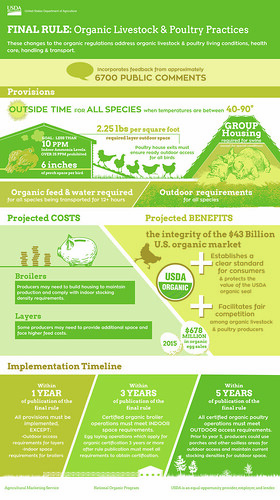
The mission of the National Organic Program, part of USDA’s Agricultural Marketing Service (AMS), is to protect the integrity of organic products in the U.S. and around the world. This means creating clear and enforceable standards that protect the organic integrity of products from farm to table. Consumers trust and look for the USDA organic seal because they know that USDA stands behind the standards that it represents.
Today, USDA announced a final rule regarding organic livestock and poultry production practices. The rule strengthens the organic standards, and ensures that all organic animals live in pasture based systems utilizing production practices that support their well-being and natural behavior. It’s an important step that will strengthen consumer confidence in the USDA organic seal and ensure that organic agriculture continues to provide economic opportunities for farmers, ranchers, and businesses across the country.
The rule clarifies how organic producers and handlers must treat their animals, brings clarity to the existing USDA organic regulations, and adds new requirements for organic livestock and poultry living conditions, transport, and slaughter practices. For example, the rule establishes minimum indoor and outdoor space requirements for organic chickens, clarifies that outdoor spaces must include soil and vegetation, adds humane handling requirements, and clarifies humane slaughter requirements.
The final rule is based on extensive input from the organic community and stakeholders. It’s consistent with direction from Congress in the Organic Foods Production Act, which provides USDA the authority to develop regulations to ensure consumers that organic products meet a consistent standard. This includes developing detailed standards for organic livestock and poultry production. The rule supports this core goal of the OFPA. The regulations that created the National Organic Program also explained that USDA would develop species-specific guidelines and space requirements for organic animals. Additionally, the National Organic Standards Board (NOSB), a 15-member advisory committee that represents all sectors of the organic community, made a number of recommendations that were vital to the development of the rule.
There are three stages to implementing the rule. Within one year, all provisions – except for outdoor access requirements for layers and indoor space requirements for broilers – must be implemented. Within three years, organic broiler operations must comply with the indoor space requirements. Within five years, all organic poultry operations must comply with the outdoor access requirements.
Most organic livestock and poultry producers already comply with the new requirements. In fact, many producers use multiple certifications to demonstrate their animal health and welfare practices to consumers. This rule could make additional animal health and welfare certifications unnecessary, reducing the burden on organic producers.
USDA offers assistance programs and services to assist producers who need to modify their operations in response to these changes. From conservation financial and technical assistance from USDA’s Natural Resources Conservation Service to loans for equipment and purchases from USDA’s Farm Service Agency, we are here to help. For a comprehensive list of resources available, visit Technical and Financial Assistance for Organic Producers. You may also visit www.usda.gov/organic to learn more about USDA’s programs and services tailored to meet the needs of the organic sector.
USDA is committed to supporting the continued growth of the organic livestock and poultry sector, and ensuring consumer confidence in the organic market, which in 2015 was worth over $43 billion in the U.S. alone. To build on this support, it has been a top priority to strengthen standards for organic livestock and poultry, ensuring that we meet consumer expectations and maintain the integrity of the USDA organic seal. You can learn more about the final rule on our website.


